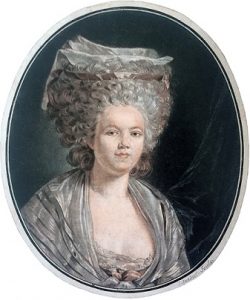28 Style Evolution of Marie Antoinette – Rose Bertin

July 2, 1747-September 22, 1813
Rose Bertin, née Marie-Jeanne Bertin, was born in in Abbeville, a textile town in northern France. At age sixteen, she was apprenticed to a marchande de modes (or milliner in English, although the literal translation is female fashion merchant) in Paris; and was so successful that in 1770 she opened up her own shop, the Grand Mogol, on the rue Saint-Honoré. Marchandes des modes were not seamstresses or tailors (a male profession) but stylists who focused on trimmings and ornamentation that would be added to an already existing gown or skirt. In the eighteenth century, surface design was more important than the cut of the dress or the cloth. Many dresses were almost invisible under the plethora of feathers, flowers, lace, ribbons, and other ornamentation. The trimmings were often times more expensive than the cloth from which the dress was made. Bertin was the first fashion designer who charged as much for her talent as her materials.
In 1774 Bertin met Marie Antoinette, who became her most famous customer although, according to her records, she had over 1,500 clients including French and European aristocracy, actresses, and even the Queens of Sweden, Spain, and Portugal. Rose was not the only modiste working for the French court, but she was the most prolific. Bertin and Marie Antoinette met twice a week to discuss the Queen’s dresses and almost every dress Marie Antoinette commissioned was a creation of Bertin. Rose Bertin was considered the first celebrity fashion designer and her work established France as the epicenter of the fashion industry. She even dressed fashion dolls, called pandoras, in her clothes at the behest of Marie Antoinette to send to her relatives across Europe. According to some sources, Bertin developed the pouf, in conjunction with Monsieur Léonard, a hairdresser who had made a name for himself creating hairdos for actresses and noblewomen. The pouf was an elaborate hairdo built on scaffolding made from wire, cloth, gauze, horsehair, fake hair, and the women’s real hair. Some poufs boasted an miniature still-life either expressing sentiment (pouf au sentiment) or to commemorate an event (pouf à la circonstance).
Your Majesty, there are no new fashions. Your majesty’s word is necessary to create them. A queen does not follow the fashion. It follows her. –Rose Bertin to Marie Antoinette, Versailles, 1772
The marchandes de modes incorporated into a guild in 1776 with Rose Bertin elected its first mistress, a testament to her success and influence. The marchandes de modes were now able to make court dresses and to play a greater role in making ordinary dresses. By 1778, Bertin was known as the Ministre des Modes or Minister of Fashion, a not entirely complimentary title.
With the advent of the French Revolution, Bertin lost a great deal of her livelihood, reduced to selling cockades in revolutionary colors, although she continued to fill orders for the imprisoned Marie Antoinette, mostly for ribbons and simple alterations. She did, however, create the mourning gown worn by the Queen after the death of Louis XVI. In 1793, Rose Bertin left Paris for London where she continued to fill orders and run her business in Paris via representatives. She returned to Paris in 1795 but her business and fortunes never recovered. She died in 1813.
Bibliography of Sources:
Bashor, Will. Marie Antoinette’s Head: The Royal Hairdresser, the Queen, and the Revolution. Guilford, Conn.: Lyons Press, 2013.
Chrisman-Campbell, Kimberly. Fashion Victims: Dress at the Court of Louis XVI and Marie-Antoinette. New Haven: Yale University Press, 2015.
Chrisman-Campbell, Kimberly. “Rose Bertin.” Encyclopedia of Clothing and Fashion, edited by Valerie Steele. Farmington Hills, MI: Charles Scribner’s Sons, 2005. Biography In Context. Accessed May 2, 2019. https://link.galegroup.com/apps/doc/K3427500070/BIC?u=wash_main&sid=BIC&xid=6d24d4ad.
Ribeiro, Aileen. Dress in Eighteenth-Century Europe 1715-1789. New Haven: Yale University Press, 2002.
“Rose Bertin”, Wikipedia: The Free Encyclopedia. Accessed 2 May 2019. https://en.wikipedia.org/wiki/Rose_Bertin.
Weber, Caroline. Queen of Fashion: What Marie Antoinette Wore to the Revolution. New York: Henry Holt and Company, 2006.
Image Citation:
Fig. 1. Jean-François Janinet , Mademoiselle Rose Bertin. No Date, etching, 11.6 × 9.9 cm. The Metropolitan Museum of Art, New York. Available from: The Metropolitan Museum of Art. Accessed May 12, 2019. https://www.metmuseum.org/art/collection/search/369411.
modiste: one who makes and sells fashionable dresses and hats for women (Merriam-Webster).


Feedback/Errata